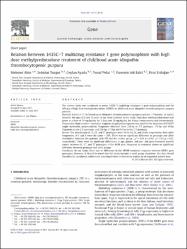Relation between 3435C > T multidrug resistance 1 gene polymorphism with high dose methylprednisolone treatment of childhood acute idiopathic thrombocytopenic purpura
Künye
Akın, M., Turgut, S., Ayada, C., Polat, Y., Işık Balcı, Y. ve Erdoğan, F. (2011). Relation between 3435C > T multidrug resistance 1 gene polymorphism with high dose methylprednisolone treatment of childhood acute idiopathic thrombocytopenic purpura. Gene, 487(1), 80-83. https://dx.doi.org/10.1016/j.gene.2011.06.019Özet
The current study was conducted to assess 3435C>T multidrug resistance 1 gene polymorphism and the efficacy of high dose methylprednisolone (HDMP) in childhood acute idiopathic thrombocytopenic purpura patients. Methods: A total of 31 childhood acute Idiopathic thrombocytopenic purpura patients (17 females, 14 males) between the ages of 2 and 16 years of age were included in the study. High-dose methylprednisolone was given at a dose of 30 mg/kg/day for 3 days and 20 mg/kg/day for 4 days, consecutively and intravenously. Polymerase chain reaction-restriction fragment length polymorphism was used for the detection of C3435T single nucleotide polymorphism. Fragments obtained were 238 bp to T/T genotype, 172 bp and 60 bp fragments to the C/C genotype, and 238 bp, 172 bp and 60 bp to the C/T genotype. Results: The distribution of CC, CT, and TT genotypes were 19.0%, 61.3%, and 19.4%, respectively. Both allele frequencies of C and T were the same -50%. There was no significant difference in genotype and allele distribution between the patients with LIP and the control group (chi(2)=0.84 p = 0.65, chi(2)=0.2 p = 0.63, respectively). There were no significant differences in age, gender, and pre- and post-treatment platelet counts between CC, CT, and TT genotypes of the MDR gene. Response to treatment shows no significant difference between genotype and allele groups. Conclusion: In our study, there was no difference in the HDMP treatment response between MDR1 gene genotypes. However, it should be noted that this study includes a small group of patients. Our data should therefore be considered preliminary, awaiting further confirmatory studies on an expanded patient base.
WoS Q Kategorisi
Q2Scopus Q Kategorisi
Q1Kaynak
GeneCilt
487Sayı
1Koleksiyonlar
- Makale Koleksiyonu [3777]
- PubMed İndeksli Yayınlar Koleksiyonu [4230]
- Scopus İndeksli Yayınlar Koleksiyonu [6574]
- WoS İndeksli Yayınlar Koleksiyonu [6631]


















